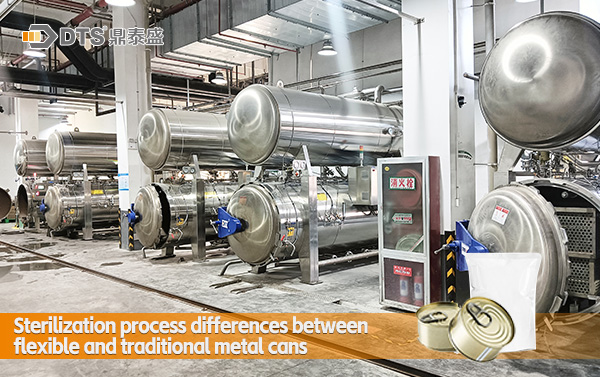


There are significant differences between flexible packaging cans and traditional metal cans in the sterilization process, mainly reflected in the following aspects:
1. Heat transfer efficiency and sterilization time
Flexible packaging cans: Due to the small thickness of flexible packaging materials and fast heat transfer, its sterilization time is usually shorter than that of metal cans. Under the same sterilization process conditions, the temperature of flexible packaging cans in the heating stage is faster, so its sterilization value (F number) is higher in the same time.
Traditional metal cans: The heat transfer efficiency of metal cans is relatively low, and it takes longer to achieve the same bactericidal effect.
2. Sterilization temperature and pressure
Soft packaging cans: usually use about 121℃ high temperature sterilization process, some products will use double peak high temperature sterilization process (such as 80℃, 5 minutes, 110℃, 5 minutes, 121℃, 12 minutes, etc.), this process can effectively reduce the sterilization intensity, reduce the deterioration of food flavor caused by high temperature.
Traditional metal cans: The sterilization temperature of metal cans is usually above 121 ° C, or even higher (such as superheated steam sterilization at 130 ° C -160 ° C), and higher pressure is required to ensure the sterilization effect.
3. The tolerance of packaging materials
Flexible packaging can: Flexible packaging materials (such as composite plastic film) in the process of high temperature sterilization, the residual gas expansion in the bag and the volume of the contents may cause the pressure in the bag to rise. Therefore, the sterilization process of flexible packaging requires special attention to pressure control to prevent the packaging from breaking.
Traditional metal cans: Metal cans have good pressure resistance and high temperature resistance, and can withstand higher sterilization temperature and pressure.
4. Cooling method
Flexible packaging cans: When cooling, water spray or air reverse pressure cooling is usually used to prevent deformation or cracking of the package.
Traditional metal cans: various cooling methods, including water cooling, air cooling, etc., but special attention needs to be paid to the balance of pressure in the tank after cooling.

5. Equipment and process flexibility
Flexible packaging can: The sterilization process of flexible packaging can use the sterilization technology and equipment of metal cans and glass cans, but it needs to be adjusted according to the characteristics of the packaging material.
Traditional metal cans: The sterilization equipment of metal cans is usually intermittent or continuous, and the process is relatively mature, but the flexibility is low.
6. Product quality and shelf life
Flexible packaging can: flexible packaging heat transfer fast, short sterilization time, can better retain the color, aroma, taste and nutrition of food, while extending the shelf life.
Traditional metal cans: Although the high temperature and high pressure sterilization process of metal cans can effectively kill microorganisms, it may lead to the loss of food flavor and nutrients.
Sum up
The sterilization technology of flexible packaging canned and traditional metal canned has its advantages and disadvantages. Flexible packaging cans perform better in terms of heat transfer efficiency, sterilization time, and product quality retention, but special attention needs to be paid to the tolerance and pressure control of packaging materials. Traditional metal cans have more advantages in pressure resistance and high temperature resistance, but may lead to the loss of flavor and nutrients. Enterprises can choose the appropriate packaging and sterilization process according to product characteristics and market demand.
